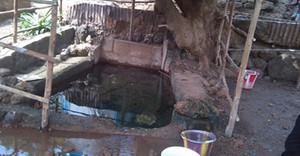Look at Figure 8.8, which shows a well that is the sole water source for a village. Based on what you can see in the photograph, undertake the following:
- Hazard assessment
- Risk assessment
- Identification of the control measures needed for each risk
- Definition of the monitoring system for each control measure.

Figure 8.8 A potential abstraction point for drinking water.
Your answers should be along the following lines:
Hazard assessment: The well is open and presents several hazards. There is no wall around it, so people or animals can contaminate the water easily, either by entering the water, or by people using contaminated utensils or containers when collecting water. There is a possibility of surface water running into it, and also wind-blown debris entering the water.
Risk assessment: The risk of contamination is high, especially since it is the sole source of water for the village, so the risk assessment score will also be high.
Identification of control measures needed for each risk: A metre-high concrete wall around the well will be an effective means of preventing direct contact with the water. A rope-and-pulley system should be set up with a bucket so that water can be drawn from the well. This water can then be put into containers brought by the people. A wall will also keep out surface run-off and wind-blown debris.
Definition of the monitoring system for each control measure: Regular inspection (say, monthly) of the wall must be undertaken to ensure that it is not cracked. The pulley-and-bucket system should also be checked (say, weekly) to ensure that it is working properly and is kept clean. The bucket should be checked for cracks.